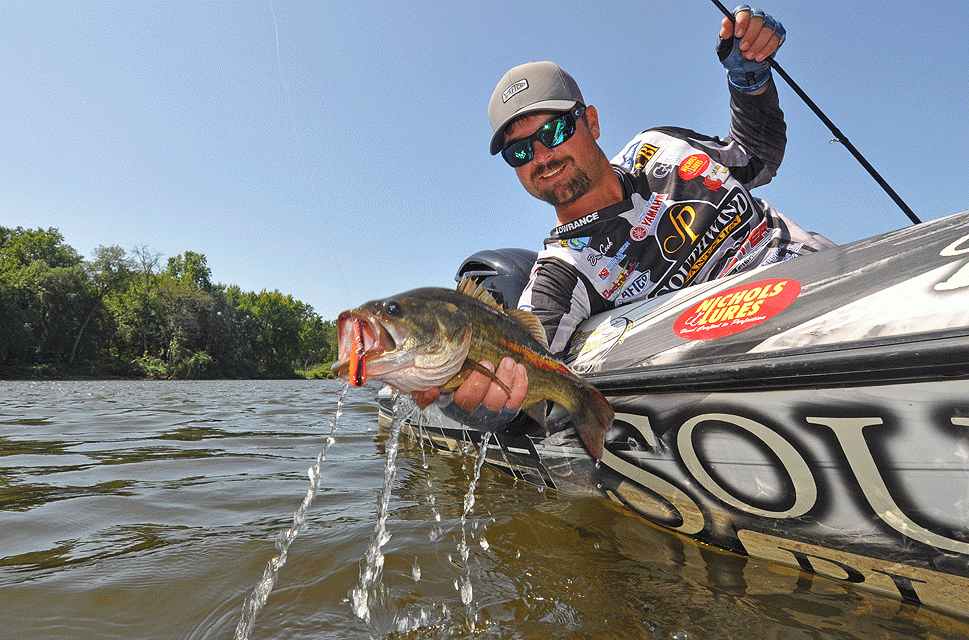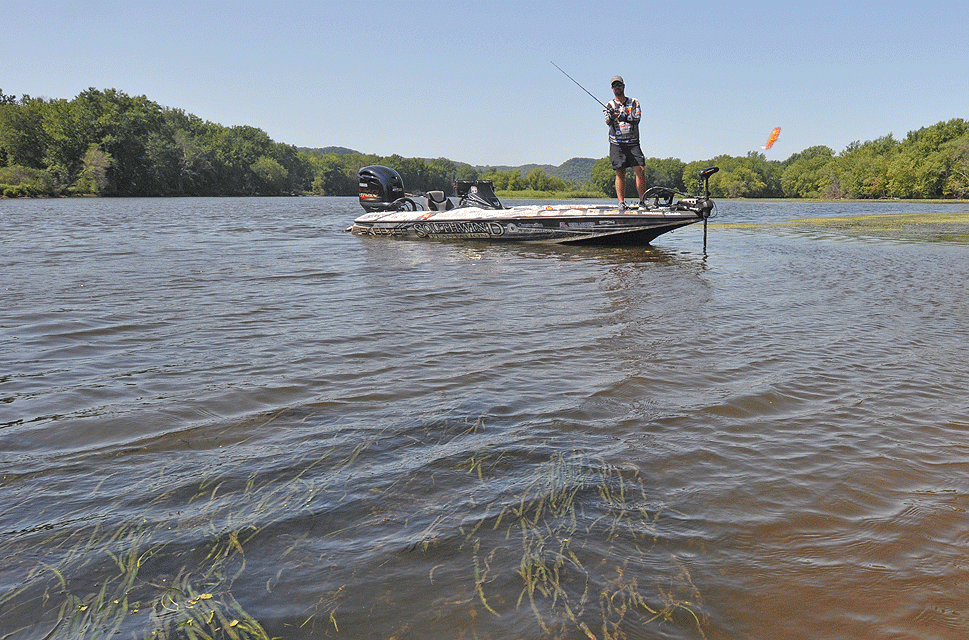
Most bass fanatics will only cast a lipless rattling crankbait in early spring over submerged grass. This tactic produced a good many bass during the 2020 Academy Sports + Outdoors Bassmaster Classic presented by Huk at Lake Guntersville, including the bulk of the 42 pounds, 15 ounces, that Florida Elite Series pro Drew Cook weighed to claim 22nd place.
His strategy during the Classic was to snatch a 1/2-ounce Spro Aruku Shad lipless crankbait out of shallow grass in pockets and points leading into pockets. The difference between Cook and other anglers is that he doesn’t limit this type of bait to fishing submerged grass prior to the spawn.
“As soon as that bite’s over most guys put their rattling crankbaits back in a box and put the box on a shelf until next spring,” he said. “I’ve always got one tied on.”
He had one tied on while competing in the 2019 Toyota Bassmaster Texas Fest at Lake Fork. The postspawn tournament took place in early May, and he found heavyweight bass relating to shell beds in less than 3 feet of water. He went to work chunking and winding a chrome black back 1/2-ounce Aruku Shad over the shell beds and finished sixth with 94 pounds, 1 ounce.
In the summertime he will wind and yo-yo a lipless crankbait over long tapering points as deep as 9 feet. Even when fishing ledges and other deeper structures offshore, he always has a rod with an Aruku Shad on deck.
“You can throw that bait a country mile,” he said. “When bass come up schooling, it’s a great bait to reach out and catch them.”
Seminole has long been one of Cook’s favorite stomping grounds for bass. He scores big with a lipless crankbait there in fall when grass mats die and uncover ditches 9 to 10 feet deep. The bass that relate to ditches that had been shielded by the mat no longer have a safe house. He gleefully picks them off with a lipless crankbait.
“Those bass haven’t seen any baits like that since they had that roof on top of them,” he said. “Most of the time a slow, steady retrieve that ticks the top of the grass growing on the bottom does the trick.”
Flats that have sparse grass and scattered stumps also yield bass to his rattling crankbaits. He has caught countless fish from stumps on Florida’s Talquin, his home lake. The stumps here are typically in 4 to 6 feet of water. Few anglers will fish a lipless crankbait in such an environment for fear of snagging.
“Everyone is so scared of hanging up,” he said. “But if the bait is running straight its head hits the cover and rolls over it like a squarebill crankbait. If you don’t set the hook when you hit the stump you’ll be fine. They’re going to bite it most of the time when it rolls off the stump.”

Losing bass
One reason anglers limit lipless crankbaits to the prespawn is that bass tend to throw these lures when they jump. Cook claims that he doesn’t lose more bass with this type of lure than with other crankbaits.
“A limber rod helps with that,” he said. “I use a 7-foot, 6-inch, Dobyns Champion XP 764 cranking rod that has a lot of give to it. It also helps you avoid snagging stumps.”
When he is aggressively ripping a lipless rattler out of submerged grass to trigger bites he opts for a high-speed reel, something with a gear ratio over 7:1.
“Once you rip the bait out of the grass, the rod is all the way back behind your head,” he said. “A lot of bass bite right then. You need a fast reel to catch up to them.”
He goes with 30- to 50-pound Seaguar Smackdown Braid when ripping a lipless crankbait through grass. He also steps up to No. 2 and No. 4 extra wide gap 2X treble hooks so he can horse the bass in before they dig themselves into the grass. Stock hooks will bend or flex under such heavy pressure and allow bass to come unglued, he pointed out.
Even with upgraded hooks the odds of losing a bass are high when only the rear treble has taken hold. When Cook sees this, he pulls the line over across the mouth of the bass to embed the front hook.
Baits and colors
The 1/2-ounce Aruku Shad is Cook’s primary lipless crankbait. If the bass are feeding on large baitfish, such as gizzard shad, he will tie on the 5/8-ounce Aruku Shad. Both baits emit a high-pitched rattling sound. In muddy conditions he fairs better with Spro’s Wameku Shad, which puts out a knocking sound.
As for colors, he keeps it simple. About 90 percent of the time he goes with chrome blue back or chrome black back. During the spring prespawn phase, the Mudbud Red color does the heavy lifting.
“Up North, say for shallow smallmouth on St. Clair, I’ll throw one a bream or perch color,” he said. “Bass don’t see that type of bait often up there.”





